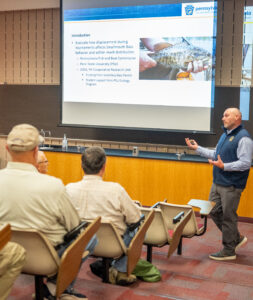Reflections in Nature: A closer look at the Osage orange tree and its fruit
By December, most plants have shed their leaves and disperse their seeds. There are many fascinating ways in which the plants ensure the dispersal of their seeds to allow successful germination. Seeds are dispersed by the wind; floating on water; hitchhiking on animal fur and being shot away from the parent plant by pressure put on the seeds.
These traveling seeds have specific features and structures that are an aid when taking advantage of the free rides. The plants usually produce an abundant supply of seeds, which are eaten by a host of wildlife.
Nature provides each plant species with an animal that seeks out its seeds, ensuring that the plant will be able to travel away from its parent.
There is one tree that does not appear to attract wildlife when its seeds are dispersed. The Osage orange tree produces an abundance of lime-colored fruits that simply fall to the ground and rot, becoming a nuisance to those homeowners having this tree growing in their yards. Nature has not designed an animal that will seek out the Osage orange fruit to feast upon its seeds.
Each lime-colored fruit ball is the size of an orange, measuring 3-5 inches in diameter. One fruit ball could contain as many as 300 seeds. Some say that squirrels feed upon the seeds, however to do this, the squirrel must spend a lot of energy in reaching the tiny seeds. Before eating, the squirrel must rip apart the tough, stringy outer fruit, and remove the slimy covering around the seed.
This is a lot of work for the squirrel when cones and nuts are easily available on other trees.
The Osage orange’s scientific name is Maclura pomifera. Thomas Nuttall gave the name Maclura in honor of his close friend, William Maclura, who was a geologist and librarian, from Harmony, Indiana.
Nuttall found the tree growing in the rich bottom land of the Red River. Pomifera comes from two Latin words pomi, which means fruit, and fera, which means bearing (a fruit-bearing tree). Although the common name of Osage comes from the Osage Indian Tribe, the orange comes from the fact that it resembles an orange; however, the fruit is not edible.
The fruit balls are made up of numerous drupes crowded together. The Osage orange is a cousin to the mulberry tree, and when looking closely at its fruit, you will see that it is an overgrown green mulberry.
Osage orange wood is stronger than white oak wood and as tough as hickory wood. The Osage Indians used the wood for making bows, arrows and war clubs. The Osage wood used in making a bow needed to be seasoned for at least seven months; however, the bow’s full strength would not be reached for about four years.
There were some people that thought the bow would not reach its full potential until it had aged ten years. In 1810, a bow made from Osage orange was so prized by the Plains Indians that it was reported the price was a horse and a blanket.
The Osage orange is dioecious, meaning that male and female flowers are produced on separate trees. The female produces the fruit, which ripens in October and falls to the ground. Female trees often produce fruit when no male trees exist nearby, but this fruit does not contain seeds.
The Osage orange tree is decay resistant and immune to termites. The inedible fruit ball contains a milky sap that could cause dermatitis. Years ago, I would receive letters in the fall from a lady asking me to send her several of the fruit. I did. She in turn sent the fruit to her son, who lived down south.
Supposedly the son used the fruit, which has a cedar-like aroma, as a deterrent for cockroaches. Some say that this only works when the fruit is green, while others say it does not work at all. The University of Iowa has found that although there are chemical compounds in the fruit that repel cockroaches, the fruit itself does not.
The tree, which is easily grown from a seed that sprouts the first year, grows rapidly to a height of approximately 50 feet. At one time, this tree, which has thorny twigs, was planted extensively as a living hedge.
A hedge was to be erected horse-high, bull-strong and pig-tight, and an Osage orange hedge met all of the requirements. After barbed wire came on the scene, Osage orange fences became obsolete.
Bill Bower is a retired Pennsylvania Game Commission Wildlife Officer. Read his blog and listen to his podcasts on the outdoors at www.onemaningreen.com.



